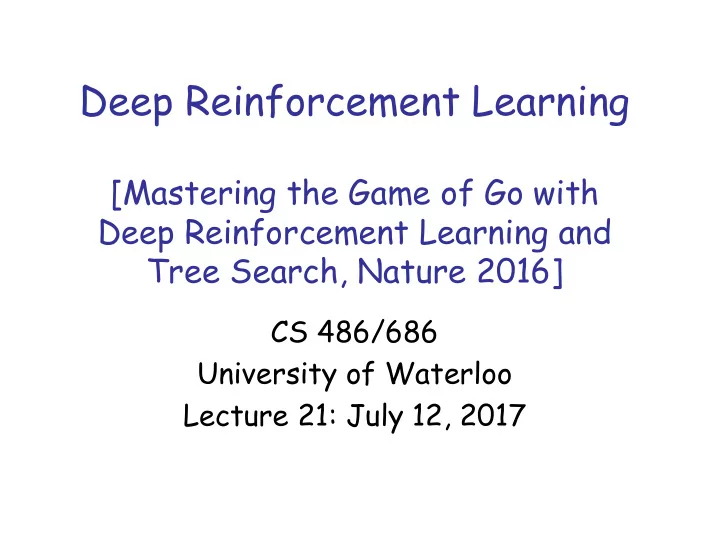

Deep Reinforcement Learning [Mastering the Game of Go with Deep Reinforcement Learning and Tree Search, Nature 2016] CS 486/686 University of Waterloo Lecture 21: July 12, 2017
Outline • AlphaGo – Supervised Learning of Policy Networks – Reinforcement Learning of Policy Networks – Reinforcement Learning of Value Networks – Searching with Policy and Value Networks 2 CS486/686 Lecture Slides (c) 2017 P. Poupart
Game of Go • (simplified) rules: – Two players (black and white) – Players alternate to place a stone of their color on a vacant intersection. – Connected stones without any liberty (i.e., no adjacent vacant intersection) are captured and removed from the board – Winner: player that controls the largest number of intersections at the end of the game 3 CS486/686 Lecture Slides (c) 2017 P. Poupart
Computer Go Deep RL Monte Carlo Tree Search • Oct 2015: • March 2016: AlphaGo defeats Lee Sedol (9-dan) 4
Winning Strategy • Four steps: 1. Supervised Learning of Policy Networks 2. Reinforcement Learning of Policy Networks 3. Reinforcement Learning of Value Networks 4. Searching with Policy and Value Networks 5 CS486/686 Lecture Slides (c) 2017 P. Poupart
Policy Network • Train policy network to imitate Go experts based on a database of 30 million board configurations from the KGS Go Server. • Policy network: – Input: state (board configuration) – Output: distribution over actions (intersection on which the next stone will be placed) 6 CS486/686 Lecture Slides (c) 2017 P. Poupart
Supervised Learning of the Policy Network • Let be the weights of the policy network • Training: – Data: suppose is optimal in – Objective: maximize – Gradient: 𝒙 – Weight update: 7 CS486/686 Lecture Slides (c) 2017 P. Poupart
Reinforcement Learning of the Policy Network • How can we update a policy network based on reinforcements instead of the optimal action? • Let be the discounted sum of rewards in a trajectory that starts in by executing . • Gradient: 𝒙 – Intuition rescale supervised learning gradient by – Formally: see derivation in [Sutton and Barto, Reinforcement learning, Chapter 13] • Weight update: 8 CS486/686 Lecture Slides (c) 2017 P. Poupart
Reinforcement Learning of the Policy Network • In computer Go, program repeatedly plays games against its former self. • For each game • For each of turn of the game, compute – Gradient: 𝒙 – Weight update: 9 CS486/686 Lecture Slides (c) 2017 P. Poupart
Value Network � • Predict (i.e., who will win game) in each state with a value network – Input: state (board configuration) – Output: expected discounted sum of rewards 10 CS486/686 Lecture Slides (c) 2017 P. Poupart
Reinforcement Learning of Value Networks • Let be the weights of the value network • Training: – Data: where – Objective: minimize – Gradient: 𝒘 – Weight update: 11 CS486/686 Lecture Slides (c) 2017 P. Poupart
Searching with Policy and Value Networks • AlphaGo combines policy and value networks into a Monte Carlo Tree Search algorithm • Idea: construct a search tree – Node: – Edge: 12 CS486/686 Lecture Slides (c) 2017 P. Poupart
Search Tree • At each edge store , , • Where is the visit count of Sample trajectory 13 CS486/686 Lecture Slides (c) 2017 P. Poupart
Simulation • At each node, select edge that maximizes • where is an exploration bonus 14 CS486/686 Lecture Slides (c) 2017 P. Poupart
Competition 15 CS486/686 Lecture Slides (c) 2017 P. Poupart
Recommend
More recommend